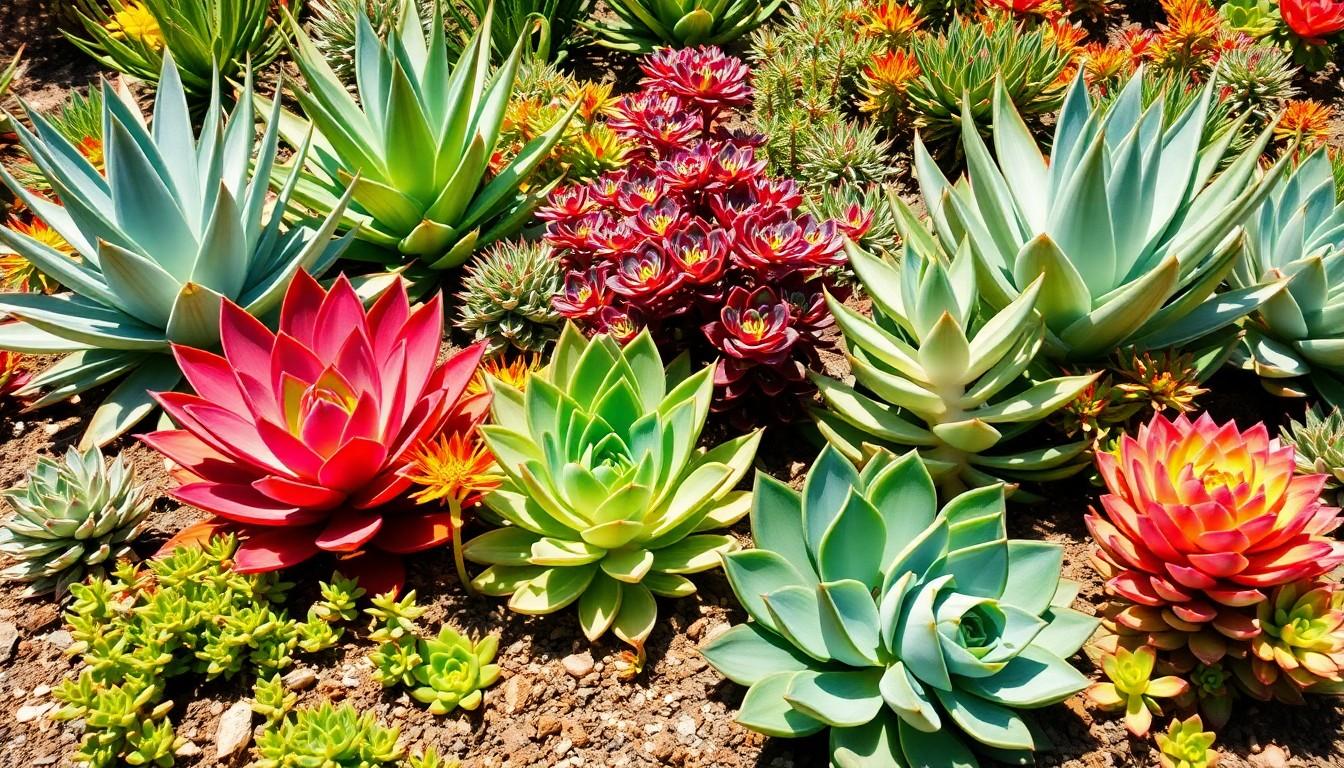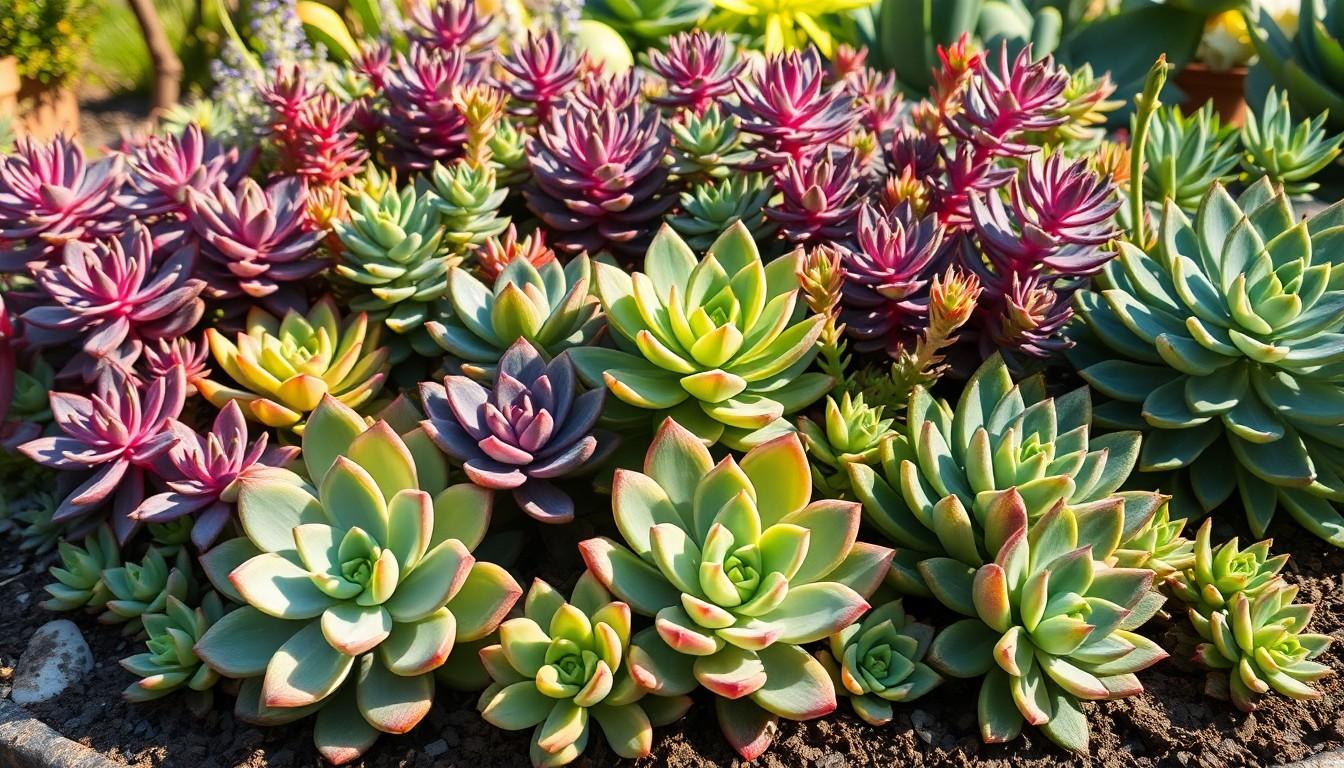Perennial succulents are the unsung heroes of the plant world, effortlessly combining beauty with low maintenance. These green wonders don’t just sit pretty; they thrive year after year, making them the perfect companions for anyone who’s ever accidentally turned a houseplant into a science experiment. With their plump leaves and vibrant colors, they’re like the party guests who always bring the fun—and they never need a ride home.
Imagine a garden that requires minimal effort but delivers maximum impact. That’s the magic of perennial succulents. Whether you’re a seasoned gardener or someone who’s just trying to keep a cactus alive, these resilient plants offer a delightful way to add life to any space. Get ready to discover why these drought-tolerant beauties deserve a prime spot in your home or garden.
Overview of Perennial Succulents
Perennial succulents represent a diverse group of plants known for their fleshy leaves and unique adaptations to arid environments. These plants retain moisture, making them exceptionally drought-tolerant. Many varieties exhibit stunning colors, including vibrant greens, deep purples, and bright pinks, which can enhance various landscapes.
Types of perennial succulents range widely. Sempervivum and Echeveria rank among the most popular choices, celebrated for their rosette shapes and resilient nature. Delosperma, commonly known as ice plant, thrives in rocky areas, boasting eye-catching flowers that bloom throughout the summer.
Cultivation practices for perennial succulents focus on well-draining soil and adequate sunlight. These plants prefer environments that mimic their native habitats, typically characterized by dry conditions. Correct watering routines contribute significantly to their health, as excessive moisture can lead to root rot.
Habitats of perennial succulents include gardens, patios, and indoor spaces. Positioning them in areas with proper light exposure fosters vibrant growth and blooming patterns. These plants often coexist well with other drought-resistant species, creating visually appealing combinations.
Landscapers frequently incorporate perennial succulents into xeriscaping projects. Their low maintenance requirements appeal to both seasoned gardeners and beginners. This ability to thrive with minimal water and care establishes them as a practical choice for sustainable gardening practices.
Perennial succulents stand out for their aesthetic appeal, diverse varieties, and hardiness. These attributes make them an excellent option for enhancing any space, ensuring beauty year after year.
Popular Types of Perennial Succulents

Perennial succulents include various popular types, each with unique characteristics. Their diversity offers many options for gardeners.
Agave Varieties
Agave species display striking architectural forms, thriving in sunny environments. Agave americana, known as the century plant, showcases large, spiky leaves that can reach several feet in length. Agave parryi, or blue agave, features stunning blue-gray leaves and is known for its drought tolerance. Agave attenuata, commonly called the foxtail agave, has soft, curved leaves that create a graceful appearance. These varieties require well-draining soil and minimal watering, making them excellent choices for low-maintenance gardens.
Sedum Varieties
Sedum species offer an array of colors and textures for garden designs. Sedum spurium, also known as Ukrainian stonecrop, produces vibrant pink flowers and spreads easily, making it great for ground cover. Sedum morganianum, or burro’s tail, features trailing, succulent leaves that create a cascading effect in container gardens. Sedum rubrotinctum, commonly called jelly bean plant, showcases plump, green leaves that turn red in bright light. These plants thrive in well-drained soil and require little water, making them perfect for xeriscaping.
Echeveria Varieties
Echeveria types present beautiful rosette shapes that enhance any space. Echeveria elegans, known as Mexican snowball, has pale blue-green leaves and produces delicate pink flowers. Echeveria compacta, or black prince, features dark, burgundy leaves and compact growth habit, providing an eye-catching contrast in gardens. Echeveria ‘Lola’ exhibits soft lavender hues and grows well in a variety of conditions. These succulents prefer bright light and well-draining soil, requiring minimal care for lasting beauty.
Growing Conditions for Perennial Succulents
Perennial succulents thrive in specific environmental conditions that ensure their health. Understanding these requirements can foster vibrant, resilient plants.
Soil Requirements
Well-draining soil remains essential for growing perennial succulents. A mix of cactus soil and sand or perlite enhances drainage, preventing root rot. Adding organic matter can provide nutrients without retaining excessive moisture. Testing soil pH between 6.0 and 7.0 works best for most varieties. Regularly checking for compaction can maintain aeration, allowing roots to breathe easily.
Watering Needs
Watering perennial succulents necessitates a careful approach. It’s crucial to allow the soil to dry out completely between waterings. Generally, watering once every two to three weeks suffices during the growing season. In winter, reducing frequency becomes important since many succulents enter dormancy. When watering, saturating the soil thoroughly ensures roots receive adequate moisture without pooling. Observing signs of overwatering, like wilted or mushy leaves, helps prevent damage.
Sunlight Preferences
Sunlight exposure plays an integral role in the growth of perennial succulents. Most varieties prefer full sun, needing at least six hours of direct sunlight daily. Providing partial shade during the hottest parts of the day can protect sensitive species. Observing plant reactions to light can guide adjustments for optimal growth. Container arrangements allow for easier movement to achieve the best light conditions, encouraging lush foliage and vibrant colors.
Care Tips for Perennial Succulents
To maintain the health and beauty of perennial succulents, focus on a few essential care practices. These plants thrive with minimal effort, making them suitable for various growing environments.
Fertilizing Techniques
Feed perennial succulents during the growing season to encourage vibrant growth. Use a balanced, water-soluble fertilizer diluted to half strength about once a month. Apply fertilizer when watering to ensure even distribution. Avoid over-fertilizing, as this can cause growth issues and leaf burn. When fall arrives, cease fertilization to allow the plants to enter dormancy. Certain soil amendments, such as compost, can also enhance nutrient availability.
Pest Management
Monitor perennial succulents for common pests like mealybugs and aphids. Inspect leaves and stems regularly for early detection. Introduce beneficial insects, such as ladybugs, to naturally control pest populations. Use insecticidal soap or neem oil for severe infestations. Always follow application instructions to avoid harming the plants. Maintaining good air circulation around succulents also minimizes pest attraction, promoting a healthier growing environment.
Conclusion
Perennial succulents stand out as an exceptional choice for gardeners seeking beauty with minimal upkeep. Their unique adaptations allow them to thrive in challenging conditions while adding vibrant colors to any space. Whether used in xeriscaping or as indoor decor, these plants offer versatility that appeals to all levels of gardening expertise.
With the right care and attention to their specific needs, perennial succulents can flourish and bring joy for years. From stunning Agave to charming Echeveria, the diverse range available ensures there’s a perfect option for every garden or home. Embracing these resilient plants not only enhances aesthetic appeal but also contributes to sustainable gardening practices.

